Building Design and Building Science: A Study of Deny Wilkinson Building at Oxford University
VerifiedAdded on 2023/06/07
|13
|3830
|300
AI Summary
This report explores the purpose, design, building methods, structural and non-structural elements, and behavior of materials of Deny Wilkinson Building at Oxford University. It includes the identification of environmental issues and mechanical and thermal characteristics of materials used. The report highlights the foundation system, methods of construction, and materials used for the substructure and superstructure of the building. It also analyzes the behavior of materials and identifies any signs of degradation or existing building defects.
Contribute Materials
Your contribution can guide someone’s learning journey. Share your
documents today.
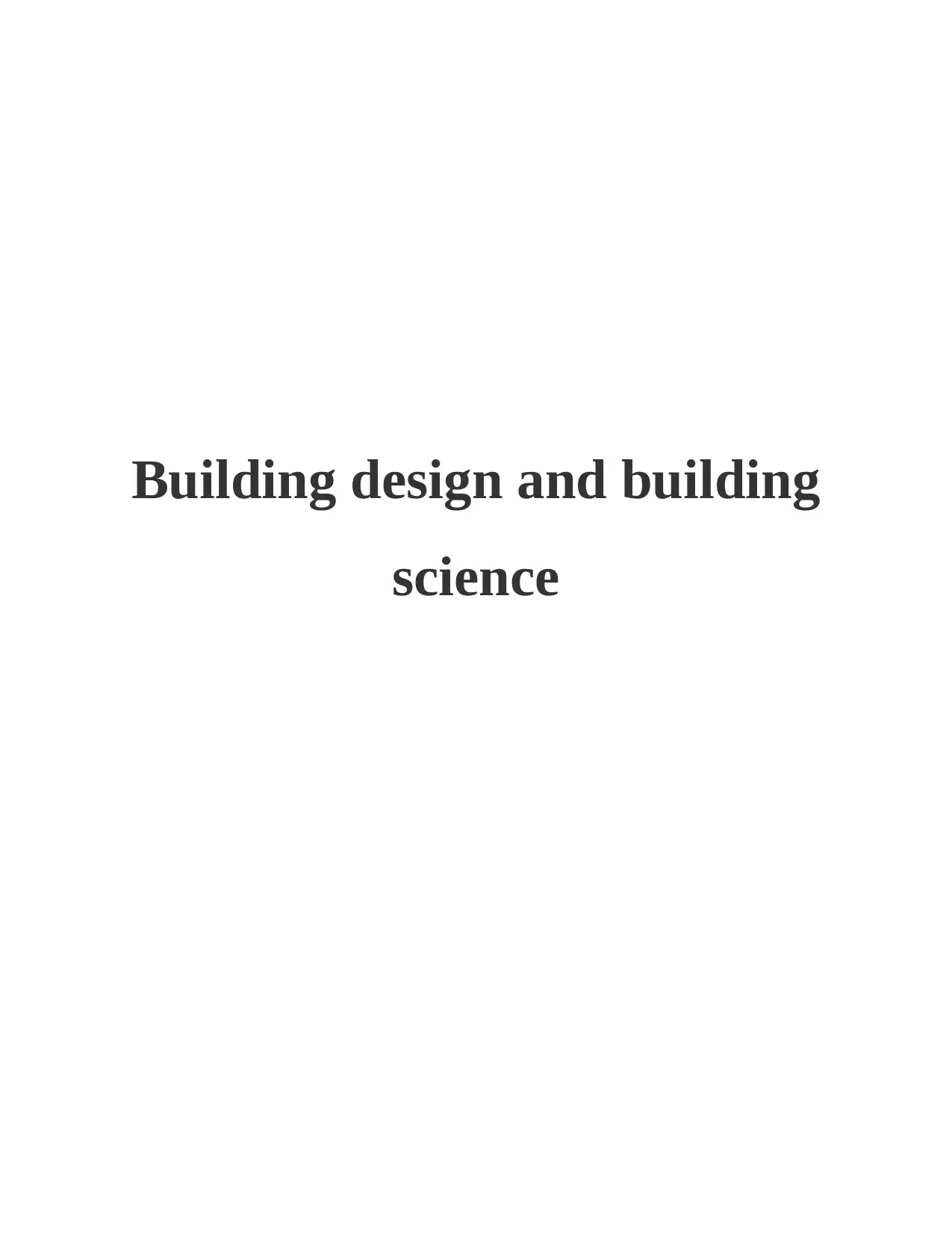
Building design and building
science
science
Secure Best Marks with AI Grader
Need help grading? Try our AI Grader for instant feedback on your assignments.

TABLE OF CONTENTS
INTRODUCTION...........................................................................................................................3
MAIN BODY..................................................................................................................................3
Identification of selected building...............................................................................................3
Structural elements......................................................................................................................5
Non-Structural elements and materials-......................................................................................7
Behaviour of materials.................................................................................................................9
CONCLUSION..............................................................................................................................11
REFERENCES..............................................................................................................................12
INTRODUCTION...........................................................................................................................3
MAIN BODY..................................................................................................................................3
Identification of selected building...............................................................................................3
Structural elements......................................................................................................................5
Non-Structural elements and materials-......................................................................................7
Behaviour of materials.................................................................................................................9
CONCLUSION..............................................................................................................................11
REFERENCES..............................................................................................................................12
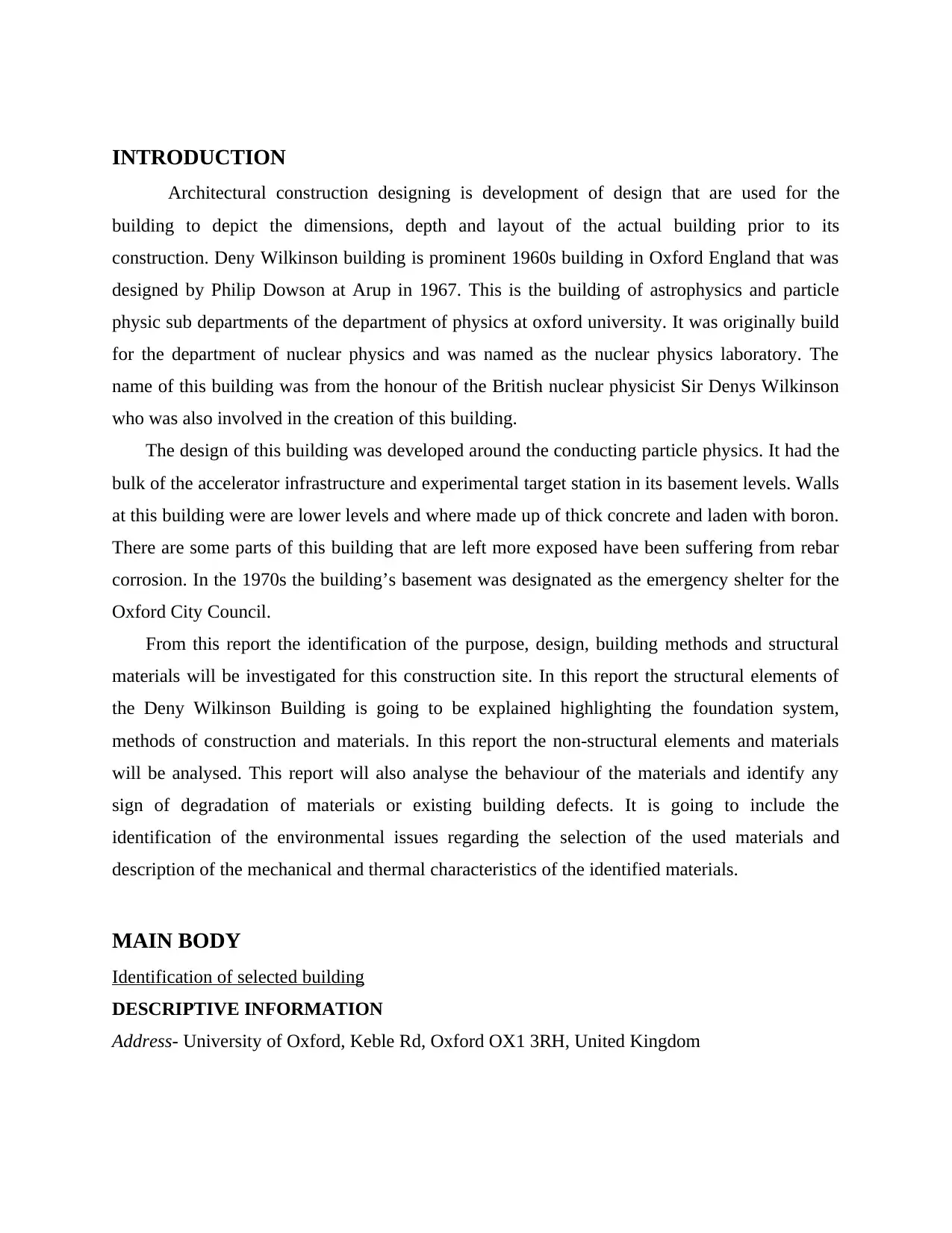
INTRODUCTION
Architectural construction designing is development of design that are used for the
building to depict the dimensions, depth and layout of the actual building prior to its
construction. Deny Wilkinson building is prominent 1960s building in Oxford England that was
designed by Philip Dowson at Arup in 1967. This is the building of astrophysics and particle
physic sub departments of the department of physics at oxford university. It was originally build
for the department of nuclear physics and was named as the nuclear physics laboratory. The
name of this building was from the honour of the British nuclear physicist Sir Denys Wilkinson
who was also involved in the creation of this building.
The design of this building was developed around the conducting particle physics. It had the
bulk of the accelerator infrastructure and experimental target station in its basement levels. Walls
at this building were are lower levels and where made up of thick concrete and laden with boron.
There are some parts of this building that are left more exposed have been suffering from rebar
corrosion. In the 1970s the building’s basement was designated as the emergency shelter for the
Oxford City Council.
From this report the identification of the purpose, design, building methods and structural
materials will be investigated for this construction site. In this report the structural elements of
the Deny Wilkinson Building is going to be explained highlighting the foundation system,
methods of construction and materials. In this report the non-structural elements and materials
will be analysed. This report will also analyse the behaviour of the materials and identify any
sign of degradation of materials or existing building defects. It is going to include the
identification of the environmental issues regarding the selection of the used materials and
description of the mechanical and thermal characteristics of the identified materials.
MAIN BODY
Identification of selected building
DESCRIPTIVE INFORMATION
Address- University of Oxford, Keble Rd, Oxford OX1 3RH, United Kingdom
Architectural construction designing is development of design that are used for the
building to depict the dimensions, depth and layout of the actual building prior to its
construction. Deny Wilkinson building is prominent 1960s building in Oxford England that was
designed by Philip Dowson at Arup in 1967. This is the building of astrophysics and particle
physic sub departments of the department of physics at oxford university. It was originally build
for the department of nuclear physics and was named as the nuclear physics laboratory. The
name of this building was from the honour of the British nuclear physicist Sir Denys Wilkinson
who was also involved in the creation of this building.
The design of this building was developed around the conducting particle physics. It had the
bulk of the accelerator infrastructure and experimental target station in its basement levels. Walls
at this building were are lower levels and where made up of thick concrete and laden with boron.
There are some parts of this building that are left more exposed have been suffering from rebar
corrosion. In the 1970s the building’s basement was designated as the emergency shelter for the
Oxford City Council.
From this report the identification of the purpose, design, building methods and structural
materials will be investigated for this construction site. In this report the structural elements of
the Deny Wilkinson Building is going to be explained highlighting the foundation system,
methods of construction and materials. In this report the non-structural elements and materials
will be analysed. This report will also analyse the behaviour of the materials and identify any
sign of degradation of materials or existing building defects. It is going to include the
identification of the environmental issues regarding the selection of the used materials and
description of the mechanical and thermal characteristics of the identified materials.
MAIN BODY
Identification of selected building
DESCRIPTIVE INFORMATION
Address- University of Oxford, Keble Rd, Oxford OX1 3RH, United Kingdom

Location Map-
Postcode- OX1 3RH
Photography of the main Façade-
Date of building- Built by prominent 1960s, Designed by Philip Dowson at Arup in 1967.
Purpose:
Denys Wilkinson Building was made with the purpose was to build for the department of
nuclear physics and was named as the Nuclear Physics Laboratory. However, it is known
Postcode- OX1 3RH
Photography of the main Façade-
Date of building- Built by prominent 1960s, Designed by Philip Dowson at Arup in 1967.
Purpose:
Denys Wilkinson Building was made with the purpose was to build for the department of
nuclear physics and was named as the Nuclear Physics Laboratory. However, it is known
Secure Best Marks with AI Grader
Need help grading? Try our AI Grader for instant feedback on your assignments.

building a house of astrophysics and particle physics sub department of the department of
physics at oxford university and also for the undergraduate teaching laboratories.
Design:
This building has been designed around the conduction of the particle physics which is
due to the purpose of making it a Nuclear physic laboratory (Lee, Bang and Kim, 2021). The
walls of the building are at the lower levels very think concrete and are laden with boron. The
design of this building includes a fan shaped super structure which is located near the building
and houses the university’s Van De Graff generator.
Building Methods:
The building methods of Denys Wilkinson Building was made with the hybrid
construction method which is a combination of wood concrete and steel to provide a more cost
effective and sustainable solution to the building structure. It is said to be improve the building
performance and design hybrid construction for the combination of different materials or
techniques to design a range of building types.
Structural materials:
As this building was made with the method of Nuclear structure its structure contained
materials which are useful for the withstanding the nuclear laboratory experiments. Apart from
the construction materials and technology also include materials such as cement, concrete
reinforcement, bricks and mortars, additives, corrosion technology, ceramics, timber, steel,
polymers, glass fibres and bituminous materials.
Structural elements
SUBSTRUCTURE
Foundation system: There basically two major types of foundation system used for
construction, shallow foundation and deep foundation. From the observation it can be
understood that this building is a deep foundation. In deep foundation pile foundation
system is the best source method which is the best for such a structure.
Methods of construction: Hybrid construction method is utilization of different materials
such as wood, concrete and steel to be able to provide a cost effective and sustainable
solution to the building structure. It is also considered to be very effective for its
performance and design (Wang and Liu, 2021). Such method is considered to be a
generally a mixture of two or more methods of construction that provides the building
physics at oxford university and also for the undergraduate teaching laboratories.
Design:
This building has been designed around the conduction of the particle physics which is
due to the purpose of making it a Nuclear physic laboratory (Lee, Bang and Kim, 2021). The
walls of the building are at the lower levels very think concrete and are laden with boron. The
design of this building includes a fan shaped super structure which is located near the building
and houses the university’s Van De Graff generator.
Building Methods:
The building methods of Denys Wilkinson Building was made with the hybrid
construction method which is a combination of wood concrete and steel to provide a more cost
effective and sustainable solution to the building structure. It is said to be improve the building
performance and design hybrid construction for the combination of different materials or
techniques to design a range of building types.
Structural materials:
As this building was made with the method of Nuclear structure its structure contained
materials which are useful for the withstanding the nuclear laboratory experiments. Apart from
the construction materials and technology also include materials such as cement, concrete
reinforcement, bricks and mortars, additives, corrosion technology, ceramics, timber, steel,
polymers, glass fibres and bituminous materials.
Structural elements
SUBSTRUCTURE
Foundation system: There basically two major types of foundation system used for
construction, shallow foundation and deep foundation. From the observation it can be
understood that this building is a deep foundation. In deep foundation pile foundation
system is the best source method which is the best for such a structure.
Methods of construction: Hybrid construction method is utilization of different materials
such as wood, concrete and steel to be able to provide a cost effective and sustainable
solution to the building structure. It is also considered to be very effective for its
performance and design (Wang and Liu, 2021). Such method is considered to be a
generally a mixture of two or more methods of construction that provides the building
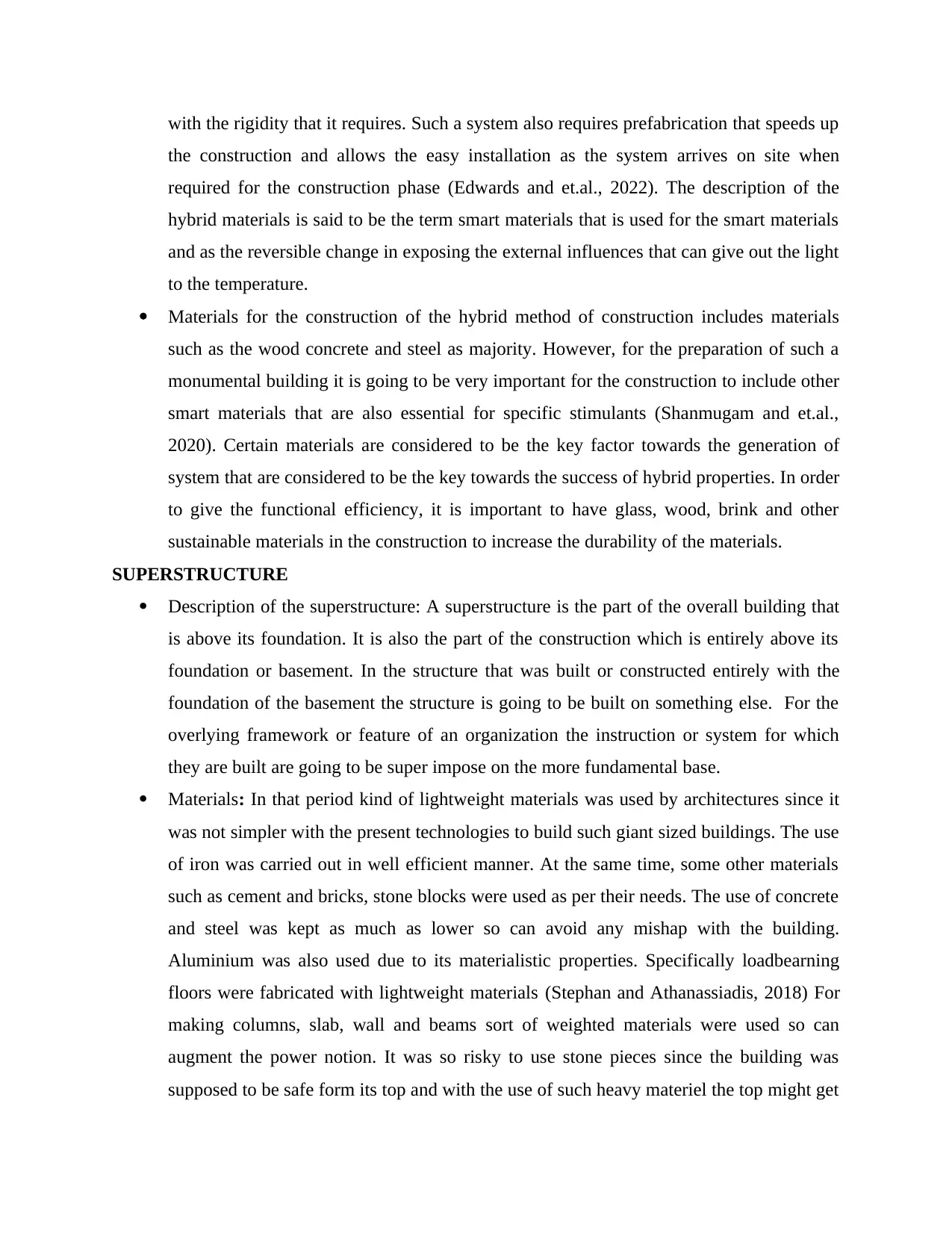
with the rigidity that it requires. Such a system also requires prefabrication that speeds up
the construction and allows the easy installation as the system arrives on site when
required for the construction phase (Edwards and et.al., 2022). The description of the
hybrid materials is said to be the term smart materials that is used for the smart materials
and as the reversible change in exposing the external influences that can give out the light
to the temperature.
Materials for the construction of the hybrid method of construction includes materials
such as the wood concrete and steel as majority. However, for the preparation of such a
monumental building it is going to be very important for the construction to include other
smart materials that are also essential for specific stimulants (Shanmugam and et.al.,
2020). Certain materials are considered to be the key factor towards the generation of
system that are considered to be the key towards the success of hybrid properties. In order
to give the functional efficiency, it is important to have glass, wood, brink and other
sustainable materials in the construction to increase the durability of the materials.
SUPERSTRUCTURE
Description of the superstructure: A superstructure is the part of the overall building that
is above its foundation. It is also the part of the construction which is entirely above its
foundation or basement. In the structure that was built or constructed entirely with the
foundation of the basement the structure is going to be built on something else. For the
overlying framework or feature of an organization the instruction or system for which
they are built are going to be super impose on the more fundamental base.
Materials: In that period kind of lightweight materials was used by architectures since it
was not simpler with the present technologies to build such giant sized buildings. The use
of iron was carried out in well efficient manner. At the same time, some other materials
such as cement and bricks, stone blocks were used as per their needs. The use of concrete
and steel was kept as much as lower so can avoid any mishap with the building.
Aluminium was also used due to its materialistic properties. Specifically loadbearning
floors were fabricated with lightweight materials (Stephan and Athanassiadis, 2018) For
making columns, slab, wall and beams sort of weighted materials were used so can
augment the power notion. It was so risky to use stone pieces since the building was
supposed to be safe form its top and with the use of such heavy materiel the top might get
the construction and allows the easy installation as the system arrives on site when
required for the construction phase (Edwards and et.al., 2022). The description of the
hybrid materials is said to be the term smart materials that is used for the smart materials
and as the reversible change in exposing the external influences that can give out the light
to the temperature.
Materials for the construction of the hybrid method of construction includes materials
such as the wood concrete and steel as majority. However, for the preparation of such a
monumental building it is going to be very important for the construction to include other
smart materials that are also essential for specific stimulants (Shanmugam and et.al.,
2020). Certain materials are considered to be the key factor towards the generation of
system that are considered to be the key towards the success of hybrid properties. In order
to give the functional efficiency, it is important to have glass, wood, brink and other
sustainable materials in the construction to increase the durability of the materials.
SUPERSTRUCTURE
Description of the superstructure: A superstructure is the part of the overall building that
is above its foundation. It is also the part of the construction which is entirely above its
foundation or basement. In the structure that was built or constructed entirely with the
foundation of the basement the structure is going to be built on something else. For the
overlying framework or feature of an organization the instruction or system for which
they are built are going to be super impose on the more fundamental base.
Materials: In that period kind of lightweight materials was used by architectures since it
was not simpler with the present technologies to build such giant sized buildings. The use
of iron was carried out in well efficient manner. At the same time, some other materials
such as cement and bricks, stone blocks were used as per their needs. The use of concrete
and steel was kept as much as lower so can avoid any mishap with the building.
Aluminium was also used due to its materialistic properties. Specifically loadbearning
floors were fabricated with lightweight materials (Stephan and Athanassiadis, 2018) For
making columns, slab, wall and beams sort of weighted materials were used so can
augment the power notion. It was so risky to use stone pieces since the building was
supposed to be safe form its top and with the use of such heavy materiel the top might get

weakened so some brick and masonry was used. Steel was a preferable thing for the
architects since they wanted such materials which may give them stronger and kind of
fracture resistant materiel than iron. At the same time, the fact can not be rejected that
iron was having sort of inferiority when it comes to comparison with steel.
Systems: To make the building quite strong a well suitable system was not possible that
time. In the 1960s there were fewer choices yet the “Hybrid Cost Model” was used
where some systems have been imparted for hiking the constructional outcomes. Mainly
Building frame system was using since the wall system was considered to be the most
affluent and it offers kind of safety (Jayakody, et. al. 2018) There were some systems
such as Floor and roof decks, horizontal system etc. Where number of key factors such as
Gravity and some lateral loads were imparted. It paved the way forward to build a strong
construction piece. These all methods were used to certain degree so it would be fair
enough to articulate that these different methods were imparted in such a manner so can
help in making a strong building. This undertaken system has used so many ideas such as
it wanted waterproof, heat resistant, and modern looking composition in order to fabricate
a strong roof. For fulfilment of the aim, they have used aluminium roofing along with
some galvanised roofing so all the perceived aims can be fulfilled.
Non-Structural elements and materials-
Non-structural elements can be defined as all the components either electrical,
architectural, mechanical which are supposed to cater the needs of human beings. Any failure of
these elements may cause safety issues to the people who are there in the building. At the same
time, all the materials which are used for fulfilment of the purpose lies in the jurisdiction of non-
structural materials.
There were number of materials were used for different structure or aims such as floor's
finishings, windows, ceiling, interior finishings and staircase etc. mainly wooden was used to
make windows and floor's finishings. The use of timber was quite rational due to availability of
the material. The used timber was brought fresh so it would not be unjust to interpret that the use
of woods somehow impacts the environment and also causes environmental issues (Truong-
Hong and Lindenbergh, 2022) The carbon emission is already a severe issue from so long. If
discusses mechanical properties then it comprises cleavage, hardness, resist impact of bending,
architects since they wanted such materials which may give them stronger and kind of
fracture resistant materiel than iron. At the same time, the fact can not be rejected that
iron was having sort of inferiority when it comes to comparison with steel.
Systems: To make the building quite strong a well suitable system was not possible that
time. In the 1960s there were fewer choices yet the “Hybrid Cost Model” was used
where some systems have been imparted for hiking the constructional outcomes. Mainly
Building frame system was using since the wall system was considered to be the most
affluent and it offers kind of safety (Jayakody, et. al. 2018) There were some systems
such as Floor and roof decks, horizontal system etc. Where number of key factors such as
Gravity and some lateral loads were imparted. It paved the way forward to build a strong
construction piece. These all methods were used to certain degree so it would be fair
enough to articulate that these different methods were imparted in such a manner so can
help in making a strong building. This undertaken system has used so many ideas such as
it wanted waterproof, heat resistant, and modern looking composition in order to fabricate
a strong roof. For fulfilment of the aim, they have used aluminium roofing along with
some galvanised roofing so all the perceived aims can be fulfilled.
Non-Structural elements and materials-
Non-structural elements can be defined as all the components either electrical,
architectural, mechanical which are supposed to cater the needs of human beings. Any failure of
these elements may cause safety issues to the people who are there in the building. At the same
time, all the materials which are used for fulfilment of the purpose lies in the jurisdiction of non-
structural materials.
There were number of materials were used for different structure or aims such as floor's
finishings, windows, ceiling, interior finishings and staircase etc. mainly wooden was used to
make windows and floor's finishings. The use of timber was quite rational due to availability of
the material. The used timber was brought fresh so it would not be unjust to interpret that the use
of woods somehow impacts the environment and also causes environmental issues (Truong-
Hong and Lindenbergh, 2022) The carbon emission is already a severe issue from so long. If
discusses mechanical properties then it comprises cleavage, hardness, resist impact of bending,
Paraphrase This Document
Need a fresh take? Get an instant paraphrase of this document with our AI Paraphraser
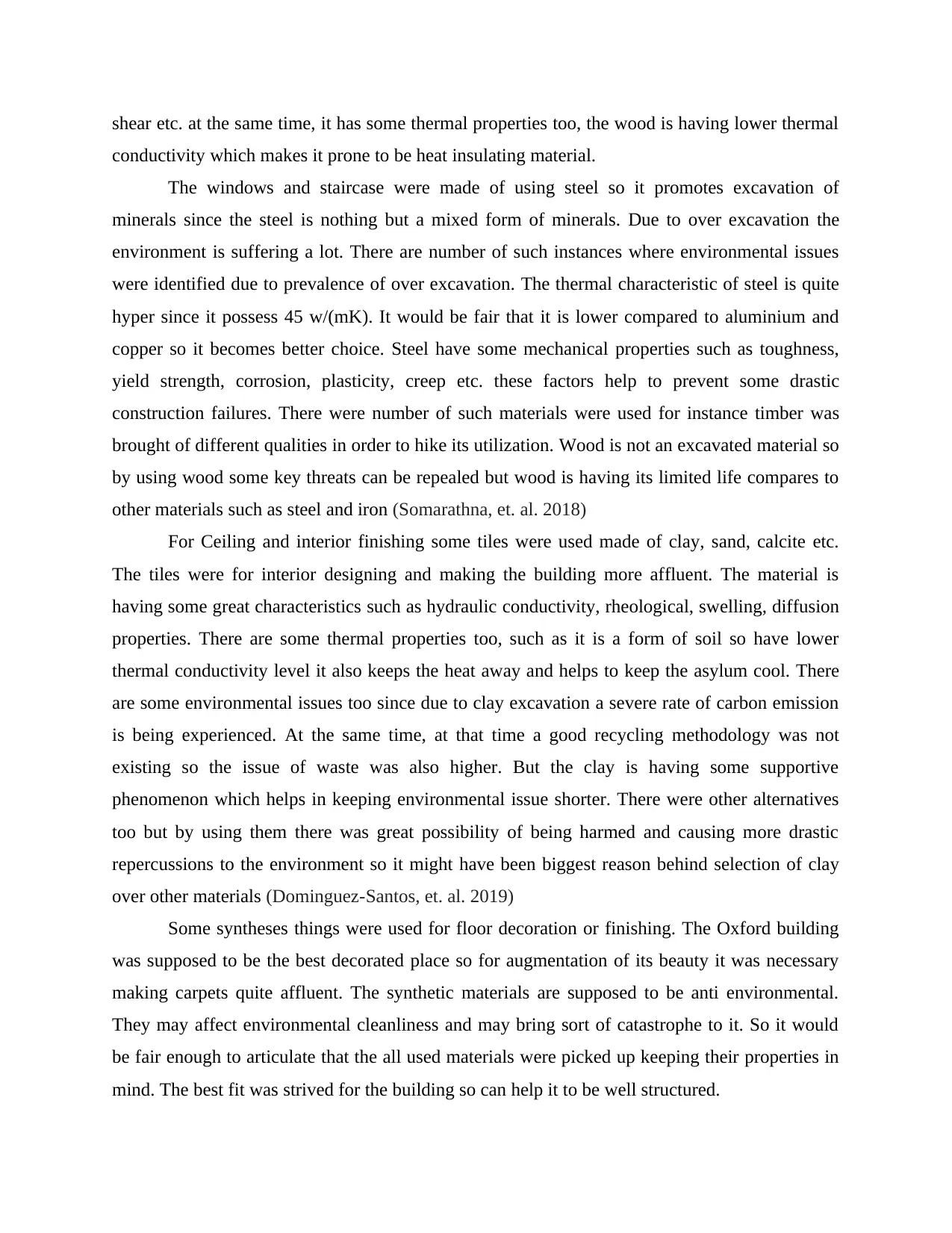
shear etc. at the same time, it has some thermal properties too, the wood is having lower thermal
conductivity which makes it prone to be heat insulating material.
The windows and staircase were made of using steel so it promotes excavation of
minerals since the steel is nothing but a mixed form of minerals. Due to over excavation the
environment is suffering a lot. There are number of such instances where environmental issues
were identified due to prevalence of over excavation. The thermal characteristic of steel is quite
hyper since it possess 45 w/(mK). It would be fair that it is lower compared to aluminium and
copper so it becomes better choice. Steel have some mechanical properties such as toughness,
yield strength, corrosion, plasticity, creep etc. these factors help to prevent some drastic
construction failures. There were number of such materials were used for instance timber was
brought of different qualities in order to hike its utilization. Wood is not an excavated material so
by using wood some key threats can be repealed but wood is having its limited life compares to
other materials such as steel and iron (Somarathna, et. al. 2018)
For Ceiling and interior finishing some tiles were used made of clay, sand, calcite etc.
The tiles were for interior designing and making the building more affluent. The material is
having some great characteristics such as hydraulic conductivity, rheological, swelling, diffusion
properties. There are some thermal properties too, such as it is a form of soil so have lower
thermal conductivity level it also keeps the heat away and helps to keep the asylum cool. There
are some environmental issues too since due to clay excavation a severe rate of carbon emission
is being experienced. At the same time, at that time a good recycling methodology was not
existing so the issue of waste was also higher. But the clay is having some supportive
phenomenon which helps in keeping environmental issue shorter. There were other alternatives
too but by using them there was great possibility of being harmed and causing more drastic
repercussions to the environment so it might have been biggest reason behind selection of clay
over other materials (Dominguez-Santos, et. al. 2019)
Some syntheses things were used for floor decoration or finishing. The Oxford building
was supposed to be the best decorated place so for augmentation of its beauty it was necessary
making carpets quite affluent. The synthetic materials are supposed to be anti environmental.
They may affect environmental cleanliness and may bring sort of catastrophe to it. So it would
be fair enough to articulate that the all used materials were picked up keeping their properties in
mind. The best fit was strived for the building so can help it to be well structured.
conductivity which makes it prone to be heat insulating material.
The windows and staircase were made of using steel so it promotes excavation of
minerals since the steel is nothing but a mixed form of minerals. Due to over excavation the
environment is suffering a lot. There are number of such instances where environmental issues
were identified due to prevalence of over excavation. The thermal characteristic of steel is quite
hyper since it possess 45 w/(mK). It would be fair that it is lower compared to aluminium and
copper so it becomes better choice. Steel have some mechanical properties such as toughness,
yield strength, corrosion, plasticity, creep etc. these factors help to prevent some drastic
construction failures. There were number of such materials were used for instance timber was
brought of different qualities in order to hike its utilization. Wood is not an excavated material so
by using wood some key threats can be repealed but wood is having its limited life compares to
other materials such as steel and iron (Somarathna, et. al. 2018)
For Ceiling and interior finishing some tiles were used made of clay, sand, calcite etc.
The tiles were for interior designing and making the building more affluent. The material is
having some great characteristics such as hydraulic conductivity, rheological, swelling, diffusion
properties. There are some thermal properties too, such as it is a form of soil so have lower
thermal conductivity level it also keeps the heat away and helps to keep the asylum cool. There
are some environmental issues too since due to clay excavation a severe rate of carbon emission
is being experienced. At the same time, at that time a good recycling methodology was not
existing so the issue of waste was also higher. But the clay is having some supportive
phenomenon which helps in keeping environmental issue shorter. There were other alternatives
too but by using them there was great possibility of being harmed and causing more drastic
repercussions to the environment so it might have been biggest reason behind selection of clay
over other materials (Dominguez-Santos, et. al. 2019)
Some syntheses things were used for floor decoration or finishing. The Oxford building
was supposed to be the best decorated place so for augmentation of its beauty it was necessary
making carpets quite affluent. The synthetic materials are supposed to be anti environmental.
They may affect environmental cleanliness and may bring sort of catastrophe to it. So it would
be fair enough to articulate that the all used materials were picked up keeping their properties in
mind. The best fit was strived for the building so can help it to be well structured.
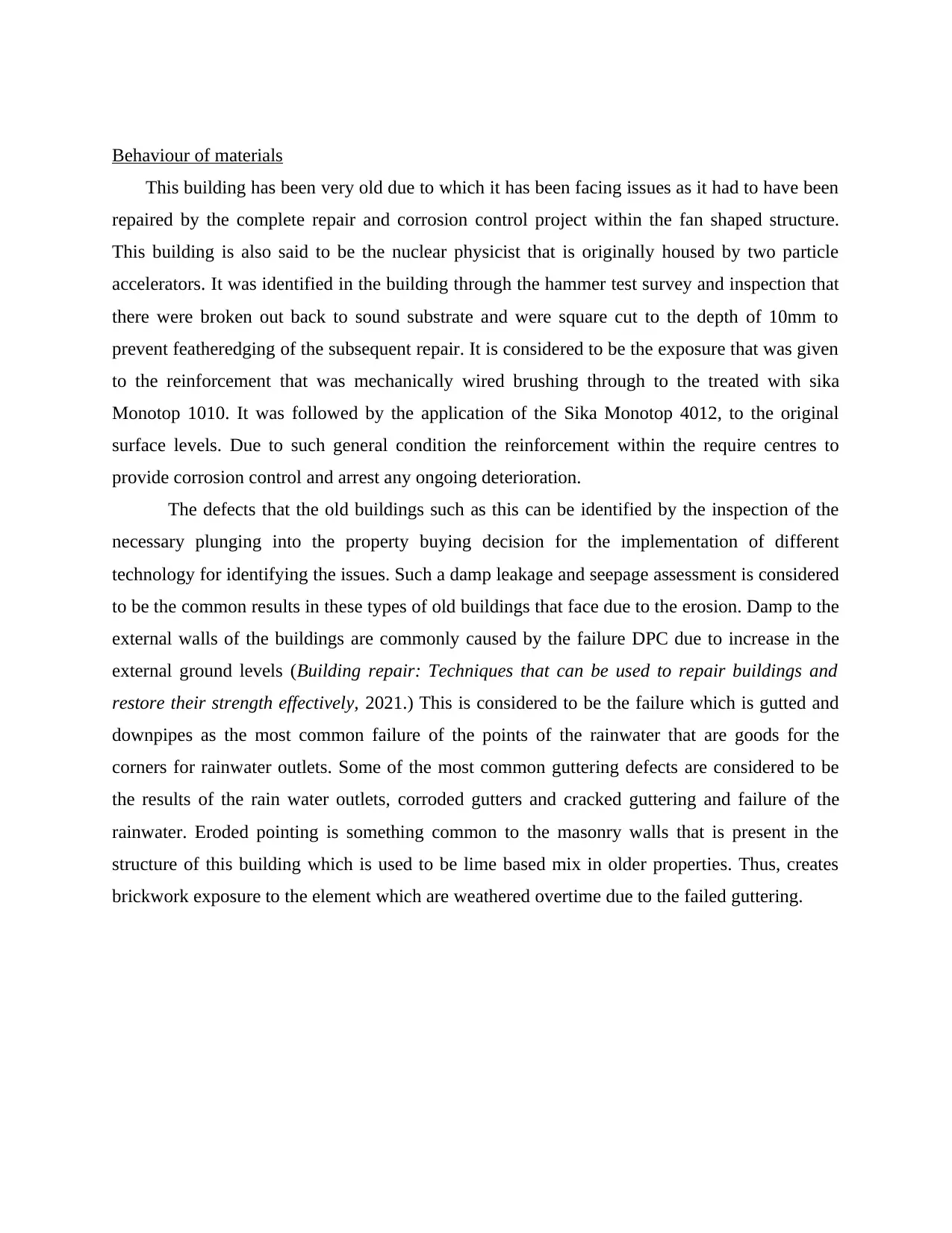
Behaviour of materials
This building has been very old due to which it has been facing issues as it had to have been
repaired by the complete repair and corrosion control project within the fan shaped structure.
This building is also said to be the nuclear physicist that is originally housed by two particle
accelerators. It was identified in the building through the hammer test survey and inspection that
there were broken out back to sound substrate and were square cut to the depth of 10mm to
prevent featheredging of the subsequent repair. It is considered to be the exposure that was given
to the reinforcement that was mechanically wired brushing through to the treated with sika
Monotop 1010. It was followed by the application of the Sika Monotop 4012, to the original
surface levels. Due to such general condition the reinforcement within the require centres to
provide corrosion control and arrest any ongoing deterioration.
The defects that the old buildings such as this can be identified by the inspection of the
necessary plunging into the property buying decision for the implementation of different
technology for identifying the issues. Such a damp leakage and seepage assessment is considered
to be the common results in these types of old buildings that face due to the erosion. Damp to the
external walls of the buildings are commonly caused by the failure DPC due to increase in the
external ground levels (Building repair: Techniques that can be used to repair buildings and
restore their strength effectively, 2021.) This is considered to be the failure which is gutted and
downpipes as the most common failure of the points of the rainwater that are goods for the
corners for rainwater outlets. Some of the most common guttering defects are considered to be
the results of the rain water outlets, corroded gutters and cracked guttering and failure of the
rainwater. Eroded pointing is something common to the masonry walls that is present in the
structure of this building which is used to be lime based mix in older properties. Thus, creates
brickwork exposure to the element which are weathered overtime due to the failed guttering.
This building has been very old due to which it has been facing issues as it had to have been
repaired by the complete repair and corrosion control project within the fan shaped structure.
This building is also said to be the nuclear physicist that is originally housed by two particle
accelerators. It was identified in the building through the hammer test survey and inspection that
there were broken out back to sound substrate and were square cut to the depth of 10mm to
prevent featheredging of the subsequent repair. It is considered to be the exposure that was given
to the reinforcement that was mechanically wired brushing through to the treated with sika
Monotop 1010. It was followed by the application of the Sika Monotop 4012, to the original
surface levels. Due to such general condition the reinforcement within the require centres to
provide corrosion control and arrest any ongoing deterioration.
The defects that the old buildings such as this can be identified by the inspection of the
necessary plunging into the property buying decision for the implementation of different
technology for identifying the issues. Such a damp leakage and seepage assessment is considered
to be the common results in these types of old buildings that face due to the erosion. Damp to the
external walls of the buildings are commonly caused by the failure DPC due to increase in the
external ground levels (Building repair: Techniques that can be used to repair buildings and
restore their strength effectively, 2021.) This is considered to be the failure which is gutted and
downpipes as the most common failure of the points of the rainwater that are goods for the
corners for rainwater outlets. Some of the most common guttering defects are considered to be
the results of the rain water outlets, corroded gutters and cracked guttering and failure of the
rainwater. Eroded pointing is something common to the masonry walls that is present in the
structure of this building which is used to be lime based mix in older properties. Thus, creates
brickwork exposure to the element which are weathered overtime due to the failed guttering.
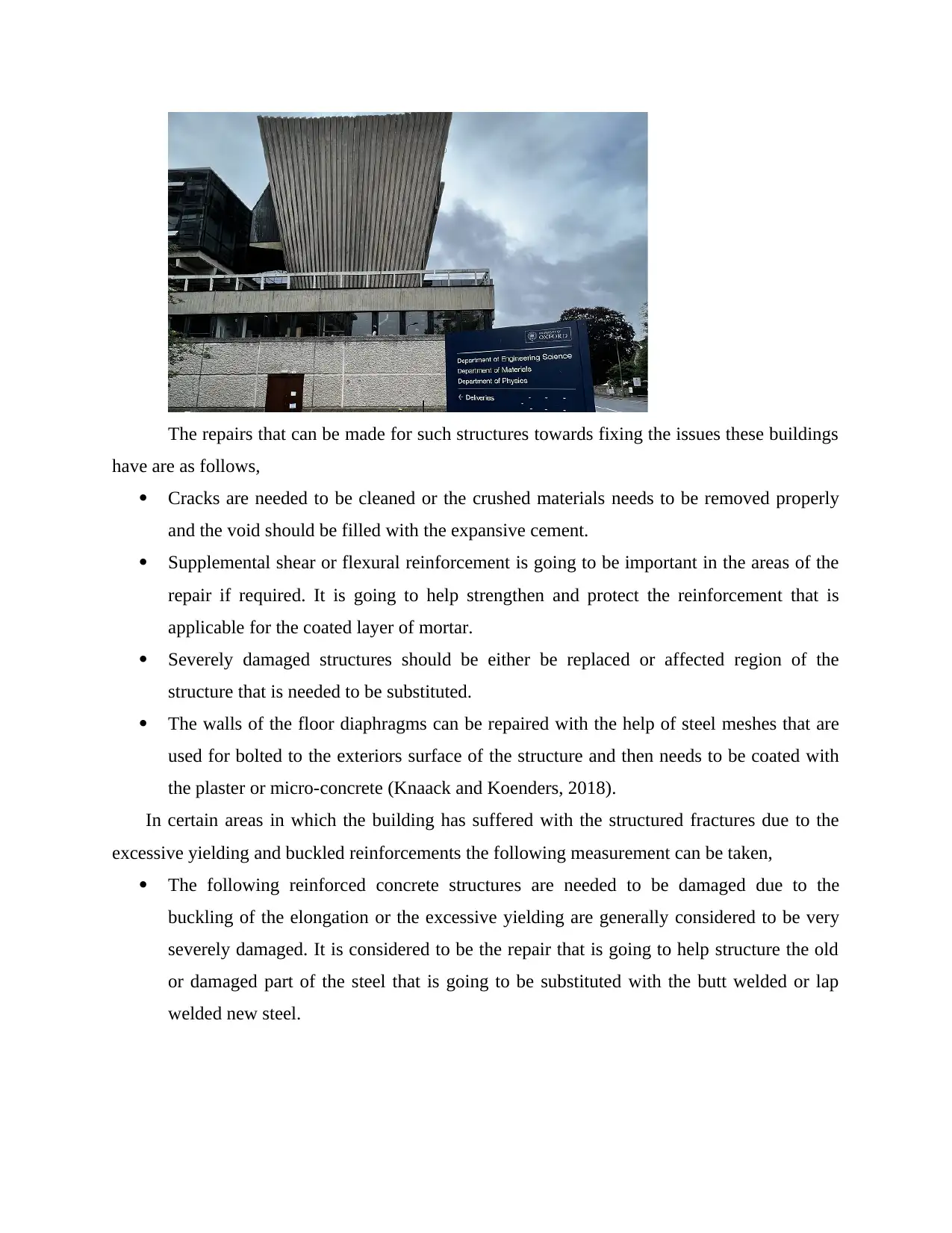
The repairs that can be made for such structures towards fixing the issues these buildings
have are as follows,
Cracks are needed to be cleaned or the crushed materials needs to be removed properly
and the void should be filled with the expansive cement.
Supplemental shear or flexural reinforcement is going to be important in the areas of the
repair if required. It is going to help strengthen and protect the reinforcement that is
applicable for the coated layer of mortar.
Severely damaged structures should be either be replaced or affected region of the
structure that is needed to be substituted.
The walls of the floor diaphragms can be repaired with the help of steel meshes that are
used for bolted to the exteriors surface of the structure and then needs to be coated with
the plaster or micro-concrete (Knaack and Koenders, 2018).
In certain areas in which the building has suffered with the structured fractures due to the
excessive yielding and buckled reinforcements the following measurement can be taken,
The following reinforced concrete structures are needed to be damaged due to the
buckling of the elongation or the excessive yielding are generally considered to be very
severely damaged. It is considered to be the repair that is going to help structure the old
or damaged part of the steel that is going to be substituted with the butt welded or lap
welded new steel.
have are as follows,
Cracks are needed to be cleaned or the crushed materials needs to be removed properly
and the void should be filled with the expansive cement.
Supplemental shear or flexural reinforcement is going to be important in the areas of the
repair if required. It is going to help strengthen and protect the reinforcement that is
applicable for the coated layer of mortar.
Severely damaged structures should be either be replaced or affected region of the
structure that is needed to be substituted.
The walls of the floor diaphragms can be repaired with the help of steel meshes that are
used for bolted to the exteriors surface of the structure and then needs to be coated with
the plaster or micro-concrete (Knaack and Koenders, 2018).
In certain areas in which the building has suffered with the structured fractures due to the
excessive yielding and buckled reinforcements the following measurement can be taken,
The following reinforced concrete structures are needed to be damaged due to the
buckling of the elongation or the excessive yielding are generally considered to be very
severely damaged. It is considered to be the repair that is going to help structure the old
or damaged part of the steel that is going to be substituted with the butt welded or lap
welded new steel.
Secure Best Marks with AI Grader
Need help grading? Try our AI Grader for instant feedback on your assignments.
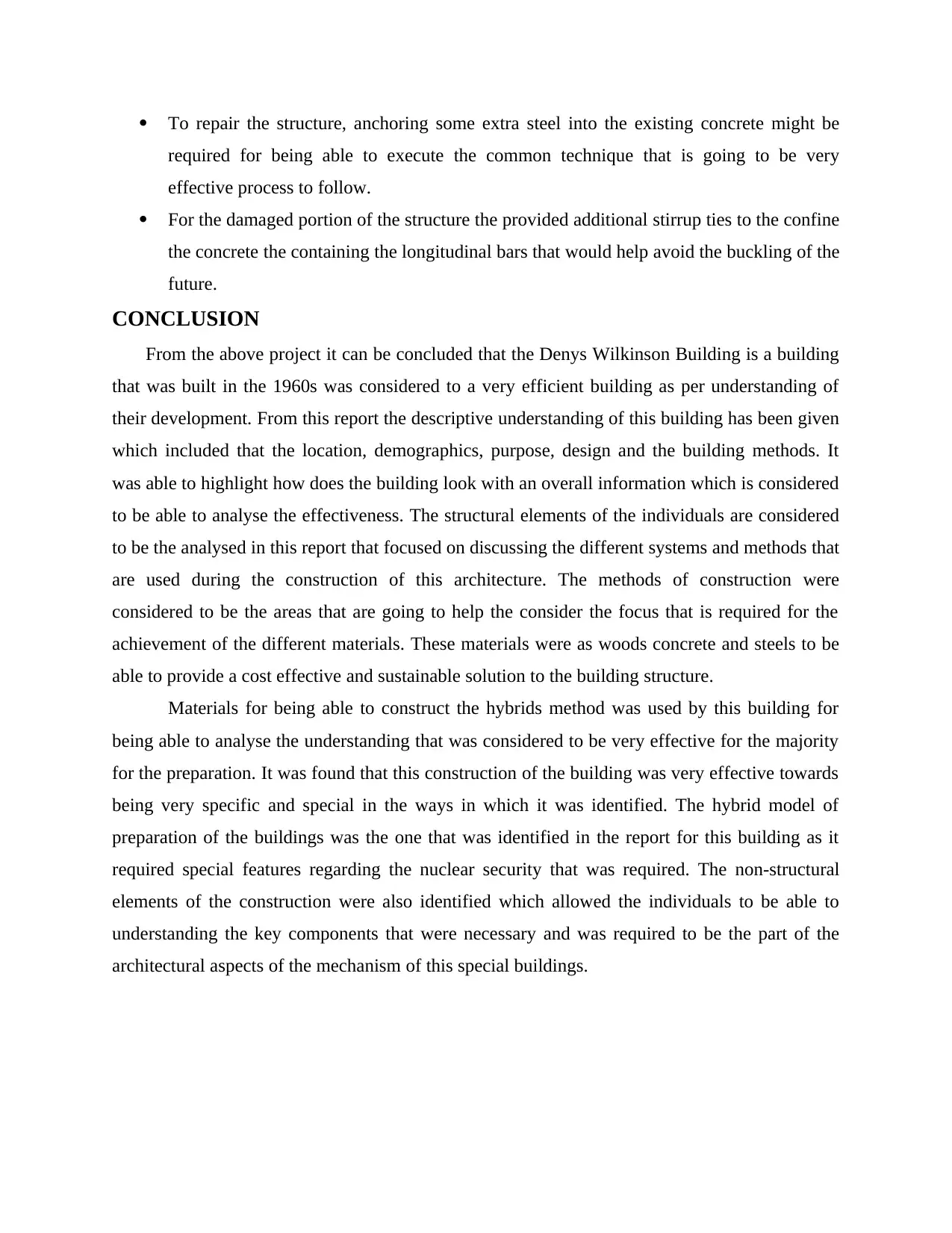
To repair the structure, anchoring some extra steel into the existing concrete might be
required for being able to execute the common technique that is going to be very
effective process to follow.
For the damaged portion of the structure the provided additional stirrup ties to the confine
the concrete the containing the longitudinal bars that would help avoid the buckling of the
future.
CONCLUSION
From the above project it can be concluded that the Denys Wilkinson Building is a building
that was built in the 1960s was considered to a very efficient building as per understanding of
their development. From this report the descriptive understanding of this building has been given
which included that the location, demographics, purpose, design and the building methods. It
was able to highlight how does the building look with an overall information which is considered
to be able to analyse the effectiveness. The structural elements of the individuals are considered
to be the analysed in this report that focused on discussing the different systems and methods that
are used during the construction of this architecture. The methods of construction were
considered to be the areas that are going to help the consider the focus that is required for the
achievement of the different materials. These materials were as woods concrete and steels to be
able to provide a cost effective and sustainable solution to the building structure.
Materials for being able to construct the hybrids method was used by this building for
being able to analyse the understanding that was considered to be very effective for the majority
for the preparation. It was found that this construction of the building was very effective towards
being very specific and special in the ways in which it was identified. The hybrid model of
preparation of the buildings was the one that was identified in the report for this building as it
required special features regarding the nuclear security that was required. The non-structural
elements of the construction were also identified which allowed the individuals to be able to
understanding the key components that were necessary and was required to be the part of the
architectural aspects of the mechanism of this special buildings.
required for being able to execute the common technique that is going to be very
effective process to follow.
For the damaged portion of the structure the provided additional stirrup ties to the confine
the concrete the containing the longitudinal bars that would help avoid the buckling of the
future.
CONCLUSION
From the above project it can be concluded that the Denys Wilkinson Building is a building
that was built in the 1960s was considered to a very efficient building as per understanding of
their development. From this report the descriptive understanding of this building has been given
which included that the location, demographics, purpose, design and the building methods. It
was able to highlight how does the building look with an overall information which is considered
to be able to analyse the effectiveness. The structural elements of the individuals are considered
to be the analysed in this report that focused on discussing the different systems and methods that
are used during the construction of this architecture. The methods of construction were
considered to be the areas that are going to help the consider the focus that is required for the
achievement of the different materials. These materials were as woods concrete and steels to be
able to provide a cost effective and sustainable solution to the building structure.
Materials for being able to construct the hybrids method was used by this building for
being able to analyse the understanding that was considered to be very effective for the majority
for the preparation. It was found that this construction of the building was very effective towards
being very specific and special in the ways in which it was identified. The hybrid model of
preparation of the buildings was the one that was identified in the report for this building as it
required special features regarding the nuclear security that was required. The non-structural
elements of the construction were also identified which allowed the individuals to be able to
understanding the key components that were necessary and was required to be the part of the
architectural aspects of the mechanism of this special buildings.
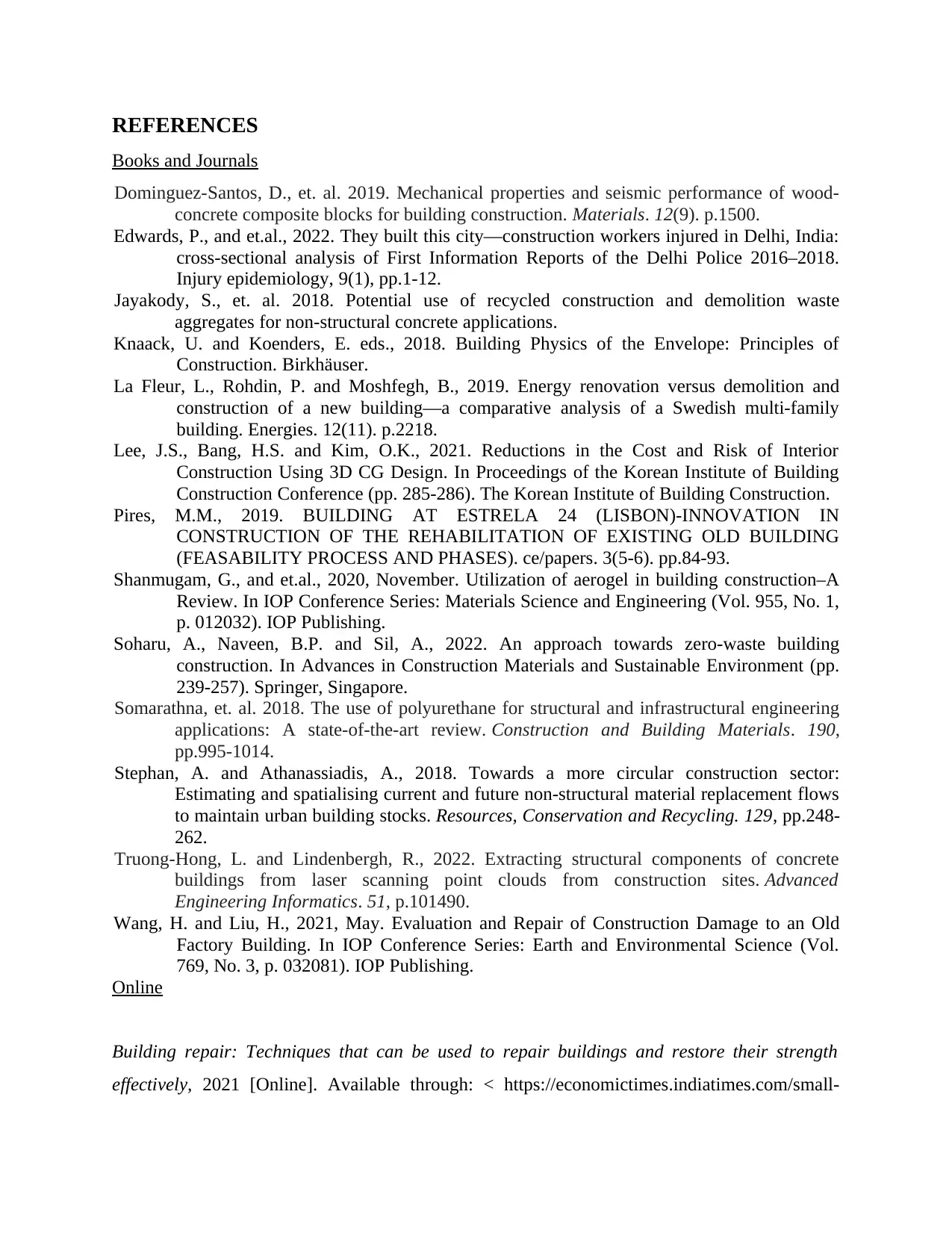
REFERENCES
Books and Journals
Dominguez-Santos, D., et. al. 2019. Mechanical properties and seismic performance of wood-
concrete composite blocks for building construction. Materials. 12(9). p.1500.
Edwards, P., and et.al., 2022. They built this city—construction workers injured in Delhi, India:
cross-sectional analysis of First Information Reports of the Delhi Police 2016–2018.
Injury epidemiology, 9(1), pp.1-12.
Jayakody, S., et. al. 2018. Potential use of recycled construction and demolition waste
aggregates for non-structural concrete applications.
Knaack, U. and Koenders, E. eds., 2018. Building Physics of the Envelope: Principles of
Construction. Birkhäuser.
La Fleur, L., Rohdin, P. and Moshfegh, B., 2019. Energy renovation versus demolition and
construction of a new building—a comparative analysis of a Swedish multi-family
building. Energies. 12(11). p.2218.
Lee, J.S., Bang, H.S. and Kim, O.K., 2021. Reductions in the Cost and Risk of Interior
Construction Using 3D CG Design. In Proceedings of the Korean Institute of Building
Construction Conference (pp. 285-286). The Korean Institute of Building Construction.
Pires, M.M., 2019. BUILDING AT ESTRELA 24 (LISBON)‐INNOVATION IN
CONSTRUCTION OF THE REHABILITATION OF EXISTING OLD BUILDING
(FEASABILITY PROCESS AND PHASES). ce/papers. 3(5-6). pp.84-93.
Shanmugam, G., and et.al., 2020, November. Utilization of aerogel in building construction–A
Review. In IOP Conference Series: Materials Science and Engineering (Vol. 955, No. 1,
p. 012032). IOP Publishing.
Soharu, A., Naveen, B.P. and Sil, A., 2022. An approach towards zero-waste building
construction. In Advances in Construction Materials and Sustainable Environment (pp.
239-257). Springer, Singapore.
Somarathna, et. al. 2018. The use of polyurethane for structural and infrastructural engineering
applications: A state-of-the-art review. Construction and Building Materials. 190,
pp.995-1014.
Stephan, A. and Athanassiadis, A., 2018. Towards a more circular construction sector:
Estimating and spatialising current and future non-structural material replacement flows
to maintain urban building stocks. Resources, Conservation and Recycling. 129, pp.248-
262.
Truong-Hong, L. and Lindenbergh, R., 2022. Extracting structural components of concrete
buildings from laser scanning point clouds from construction sites. Advanced
Engineering Informatics. 51, p.101490.
Wang, H. and Liu, H., 2021, May. Evaluation and Repair of Construction Damage to an Old
Factory Building. In IOP Conference Series: Earth and Environmental Science (Vol.
769, No. 3, p. 032081). IOP Publishing.
Online
Building repair: Techniques that can be used to repair buildings and restore their strength
effectively, 2021 [Online]. Available through: < https://economictimes.indiatimes.com/small-
Books and Journals
Dominguez-Santos, D., et. al. 2019. Mechanical properties and seismic performance of wood-
concrete composite blocks for building construction. Materials. 12(9). p.1500.
Edwards, P., and et.al., 2022. They built this city—construction workers injured in Delhi, India:
cross-sectional analysis of First Information Reports of the Delhi Police 2016–2018.
Injury epidemiology, 9(1), pp.1-12.
Jayakody, S., et. al. 2018. Potential use of recycled construction and demolition waste
aggregates for non-structural concrete applications.
Knaack, U. and Koenders, E. eds., 2018. Building Physics of the Envelope: Principles of
Construction. Birkhäuser.
La Fleur, L., Rohdin, P. and Moshfegh, B., 2019. Energy renovation versus demolition and
construction of a new building—a comparative analysis of a Swedish multi-family
building. Energies. 12(11). p.2218.
Lee, J.S., Bang, H.S. and Kim, O.K., 2021. Reductions in the Cost and Risk of Interior
Construction Using 3D CG Design. In Proceedings of the Korean Institute of Building
Construction Conference (pp. 285-286). The Korean Institute of Building Construction.
Pires, M.M., 2019. BUILDING AT ESTRELA 24 (LISBON)‐INNOVATION IN
CONSTRUCTION OF THE REHABILITATION OF EXISTING OLD BUILDING
(FEASABILITY PROCESS AND PHASES). ce/papers. 3(5-6). pp.84-93.
Shanmugam, G., and et.al., 2020, November. Utilization of aerogel in building construction–A
Review. In IOP Conference Series: Materials Science and Engineering (Vol. 955, No. 1,
p. 012032). IOP Publishing.
Soharu, A., Naveen, B.P. and Sil, A., 2022. An approach towards zero-waste building
construction. In Advances in Construction Materials and Sustainable Environment (pp.
239-257). Springer, Singapore.
Somarathna, et. al. 2018. The use of polyurethane for structural and infrastructural engineering
applications: A state-of-the-art review. Construction and Building Materials. 190,
pp.995-1014.
Stephan, A. and Athanassiadis, A., 2018. Towards a more circular construction sector:
Estimating and spatialising current and future non-structural material replacement flows
to maintain urban building stocks. Resources, Conservation and Recycling. 129, pp.248-
262.
Truong-Hong, L. and Lindenbergh, R., 2022. Extracting structural components of concrete
buildings from laser scanning point clouds from construction sites. Advanced
Engineering Informatics. 51, p.101490.
Wang, H. and Liu, H., 2021, May. Evaluation and Repair of Construction Damage to an Old
Factory Building. In IOP Conference Series: Earth and Environmental Science (Vol.
769, No. 3, p. 032081). IOP Publishing.
Online
Building repair: Techniques that can be used to repair buildings and restore their strength
effectively, 2021 [Online]. Available through: < https://economictimes.indiatimes.com/small-

biz/productline/building-materials/building-repair-techniques-that-can-be-used-to-repair-
buildings-and-restore-their-strength-effectively/articleshow/70450095.cms?from=mdr>
[Online]. Available through: <>
buildings-and-restore-their-strength-effectively/articleshow/70450095.cms?from=mdr>
[Online]. Available through: <>
1 out of 13
Your All-in-One AI-Powered Toolkit for Academic Success.
+13062052269
info@desklib.com
Available 24*7 on WhatsApp / Email
![[object Object]](/_next/static/media/star-bottom.7253800d.svg)
Unlock your academic potential
© 2024 | Zucol Services PVT LTD | All rights reserved.